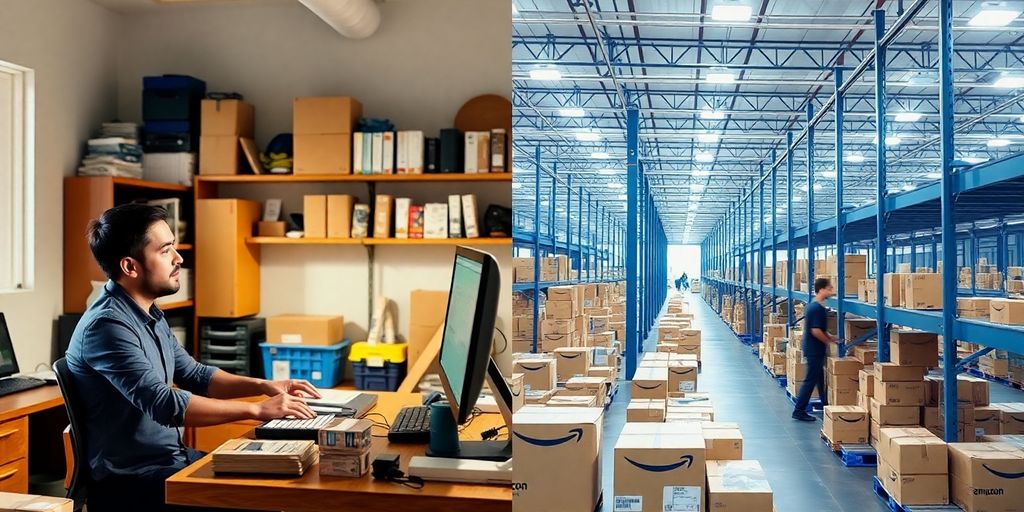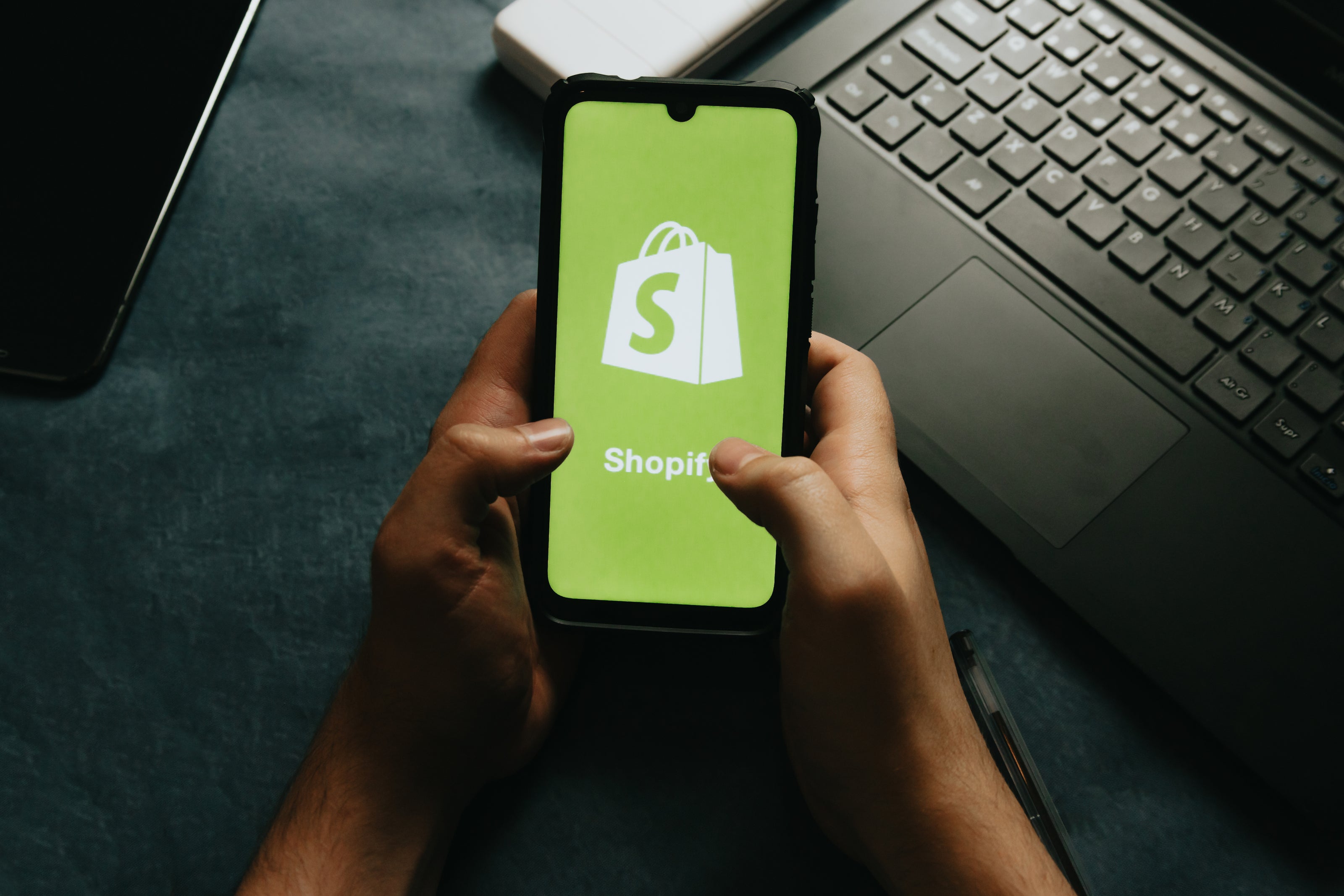
Difference between dropshipping and amazon FBA
Share
Alright, so you're thinking about jumping into the world of e-commerce, and you've probably heard about dropshipping and Amazon FBA. They both sound pretty cool, right? I mean, who wouldn't want a hands-off way to sell stuff online? But here's the catch: they're not the same thing. And figuring out which one is right for you can be a bit of a head-scratcher. So, let's break it down in simple terms and see what each has to offer.
Key Takeaways
- Dropshipping requires no upfront inventory, but you have less control over product quality and delivery times.
- With Amazon FBA, you send your inventory to Amazon, and they handle the fulfillment and customer service for you.
- Dropshipping allows for more flexibility with products and suppliers, but can have slower shipping times.
- Amazon FBA offers faster delivery with Prime shipping but comes with various fees.
- Both models have their own set of challenges, so it's important to weigh the pros and cons based on your business needs.
Understanding the Basics of Dropshipping and Amazon FBA

Definition of Dropshipping
Dropshipping is a retail fulfillment method where a store doesn't keep the products it sells in stock. Instead, when a store sells a product, it purchases the item from a third party and has it shipped directly to the customer. As a result, the seller doesn't have to handle the product directly. This business model is attractive because it requires minimal upfront investment, no need for a physical store, and offers flexibility in managing inventory.
Definition of Amazon FBA
Fulfillment by Amazon (FBA) is a service provided by Amazon that allows sellers to store their products in Amazon's fulfillment centers. Amazon then takes care of picking, packing, shipping, and customer service for these products. Sellers send their inventory to Amazon, and once a customer makes a purchase, Amazon handles the logistics. This model is appealing due to Amazon's vast customer base and the convenience of Amazon Prime's fast shipping.
Key Differences in Fulfillment
- Inventory Management: In dropshipping, the supplier manages the inventory, while in Amazon FBA, sellers must send their products to Amazon's warehouses.
- Shipping and Handling: Dropshipping suppliers handle shipping directly to customers. Amazon FBA, however, takes charge of shipping through its logistics network.
- Control Over Branding: With dropshipping, there is limited control over packaging and branding, as the supplier handles these aspects. In contrast, Amazon FBA allows for more control over how products are presented to customers.
Choosing between dropshipping and Amazon FBA depends on your business goals, resources, and how much control you want over your brand. Dropshipping offers flexibility and lower initial costs, while Amazon FBA provides access to a large customer base and operational support.
Inventory Management: Dropshipping vs. Amazon FBA

Ownership of Inventory
In dropshipping, the seller doesn't own the inventory. Instead, they rely on suppliers to maintain stock and fulfill orders. This means the seller only purchases the product once a customer places an order. On the other hand, Amazon FBA requires sellers to buy inventory upfront and send it to Amazon's warehouses. This gives FBA sellers more control over their stock but involves higher upfront costs.
Storage Requirements
For dropshipping, there's no need for storage space since the supplier handles all inventory. This eliminates costs associated with warehousing. In contrast, Amazon FBA sellers must send their products to Amazon's fulfillment centers, where storage fees apply. While FBA provides a streamlined storage solution, it comes with its own set of expenses.
Inventory Tracking
Tracking inventory can be a challenge in dropshipping. Since sellers depend on multiple suppliers, real-time inventory updates aren't always possible. This can lead to stockouts and disappointed customers if not managed carefully. Amazon FBA, however, offers robust inventory tracking with notifications for low stock levels, helping sellers maintain optimal stock and avoid running out of products.
Cost Implications of Dropshipping and Amazon FBA
Initial Investment Requirements
Starting a business often hinges on the initial costs involved. Dropshipping offers a significant advantage here with its low startup costs. Entrepreneurs can dive into e-commerce without the burden of purchasing large inventories upfront. This model is appealing for those looking to minimize financial risk. On the other hand, Amazon FBA requires a more substantial initial investment. Sellers need to purchase inventory in bulk and ship it to Amazon's warehouses, which means upfront costs can be quite high.
Ongoing Fees and Expenses
Both dropshipping and Amazon FBA have their ongoing costs, but they differ significantly. With dropshipping, you avoid storage fees since there's no need to keep inventory. However, you might face higher product costs due to buying items individually from suppliers. Amazon FBA, conversely, involves various fees including storage, fulfillment, and potential long-term storage fees if products don't sell quickly. These fees can add up, making it crucial for sellers to manage their inventory effectively.
Profit Margins
Profit margins can vary widely between these two models. Dropshipping typically offers lower profit margins due to higher product costs and intense competition. Since you rely on suppliers, you also have less control over pricing. Amazon FBA can potentially offer higher margins, especially if you manage to source products at a lower cost and sell them at a competitive price on Amazon's platform. However, the fees associated with FBA can eat into these margins if not carefully managed.
Choosing between dropshipping and Amazon FBA often comes down to weighing the cost implications against potential profits. Dropshipping provides a low-risk entry point into e-commerce, ideal for those cautious about spending. Meanwhile, Amazon FBA might suit those ready to invest more upfront for potentially greater returns.
Shipping and Delivery: A Comparative Analysis
Shipping Speed and Reliability
When it comes to shipping speed, Amazon FBA has a clear edge. Amazon's vast network of warehouses allows them to offer fast, often two-day shipping through Amazon Prime, which is a significant advantage. Dropshipping, on the other hand, depends heavily on the supplier's location and efficiency. This can lead to longer shipping times, especially if the supplier is overseas.
| Aspect | Amazon FBA | Dropshipping |
|---|---|---|
| Shipping Speed | Fast (2-day Prime) | Varies by supplier |
| Reliability | High | Medium |
Handling Returns and Customer Service
Amazon FBA takes care of returns and customer service, which can be a huge relief for sellers. They handle customer inquiries, returns, and refunds, allowing sellers to focus on other aspects of their business. With dropshipping, the responsibility falls on the seller to manage returns and deal with any customer service issues, which can be time-consuming and complex.
- Amazon FBA:
- Dropshipping:
Impact on Customer Satisfaction
Customer satisfaction is closely tied to shipping speed and the ease of returns. With Amazon FBA, customers generally enjoy quicker deliveries and a straightforward return process, which boosts satisfaction. In contrast, the variable shipping times and potentially complicated return processes in dropshipping can lead to customer dissatisfaction if not managed properly.
Choosing between drop shipping fulfillment and third-party logistics requires careful consideration of shipping reliability and customer service capabilities. Each model offers unique benefits and challenges that can significantly impact customer satisfaction and business success.
Scalability and Growth Potential
Opportunities for Business Expansion
When it comes to growing a business, both dropshipping and Amazon FBA present unique opportunities. Dropshipping is often seen as a lower-risk option for expansion. Since there's no need to purchase inventory upfront, sellers can test new products without significant financial risk. This model is particularly appealing for entrepreneurs who want to experiment with a variety of products or enter new markets quickly. On the other hand, Amazon FBA offers a more structured path to scaling. Sellers can leverage Amazon's vast logistics network to handle increased sales volumes, which is beneficial for those aiming to establish a strong brand presence on the platform.
Challenges in Scaling Operations
Scaling a dropshipping business, while flexible, can bring its own set of challenges. One major issue is supplier reliability. As the business grows, maintaining consistent quality and delivery times can become problematic if the suppliers are not dependable. Additionally, the competition is fierce, with many sellers offering similar products, which can drive down prices and profit margins.
For Amazon FBA sellers, scaling operations involves navigating Amazon's complex fee structures and inventory management requirements. As sales increase, so do the storage and fulfillment fees, which can eat into profits if not carefully managed. Moreover, FBA is preferable for sellers seeking control and brand development, while dropshipping suits those who prioritize flexibility.
Long-term Business Viability
In terms of long-term viability, both models have their advantages and potential pitfalls. Dropshipping allows for a nimble business model that can adapt quickly to market changes, but it often lacks brand loyalty and customer retention. Without a strong brand identity, it can be difficult to sustain a competitive edge in the long term.
Amazon FBA, however, offers more stability in terms of brand building and customer trust. Sellers can create a more personalized customer experience by controlling packaging and branding. However, they are also more susceptible to Amazon's policy changes and the associated risks of having a large portion of their business tied to a single platform.
Choosing between dropshipping and Amazon FBA depends largely on the seller's goals and resources. While dropshipping offers flexibility and low upfront costs, Amazon FBA provides a robust framework for brand development and scalability. Understanding these differences is crucial for making an informed decision about which path to pursue.
Branding and Customer Experience

Control Over Branding and Packaging
When it comes to dropshipping, sellers have a lot of freedom in crafting their brand's image. They can design their own websites and even decide on the packaging style, making sure everything aligns with their brand identity. This flexibility allows for a more personal touch, helping businesses stand out in a crowded market. In contrast, Amazon FBA has more restrictions. Sellers must adhere to Amazon's packaging standards, which might limit how much they can showcase their brand's uniqueness.
Customer Interaction and Engagement
Customer interaction is another area where dropshipping and Amazon FBA differ significantly. Dropshippers often handle their own customer service, giving them the chance to build direct relationships with their customers. This can be a double-edged sword, though, as it means they're also responsible for dealing with any issues that arise. Amazon FBA, on the other hand, takes care of customer service for sellers. This can reduce the workload for sellers but also means they have less direct contact with their customers.
Building Brand Loyalty
Creating brand loyalty is all about consistency and trust. Dropshipping businesses can foster loyalty by maintaining a consistent brand voice across all customer touchpoints, from their website to social media interactions. However, the variability in product quality and shipping times can sometimes pose challenges. Amazon FBA offers reliable shipping and a trusted platform, which can help in building customer trust. However, the lack of direct branding opportunities might make it harder for sellers to create a unique brand identity that customers remember.
Balancing brand control and customer experience is crucial in selecting the right business model. While dropshipping offers more freedom in branding, Amazon FBA provides a structured environment that can enhance customer trust through reliable service.
Risk Factors and Challenges
Common Issues in Dropshipping
Dropshipping can be a great way to start an online business with minimal upfront costs, but it's not without its pitfalls. One of the biggest challenges is relying heavily on suppliers. If they fail to deliver on time or provide poor-quality products, your business reputation can suffer. Here are some common issues faced by dropshippers:
- Shipping Delays: When you rely on third-party suppliers, shipping delays can be frequent and frustrating.
- Quality Control: Without direct oversight, ensuring product quality can be challenging.
- Inventory Management: Keeping track of stock levels when working with multiple suppliers can lead to discrepancies and stockouts.
Managing these issues requires a solid plan and constant communication with suppliers to ensure smooth operations.
Challenges Faced by Amazon FBA Sellers
Amazon FBA offers a streamlined way to manage logistics, but it comes with its own set of challenges. The most notable include:
- High Competition: With millions of sellers on Amazon, standing out can be tough.
- Fee Structure: The fees associated with FBA can eat into profit margins if not carefully managed.
- Compliance Requirements: Ensuring that all products meet Amazon's strict guidelines can be demanding.
Mitigating Risks in Both Models
Whether you choose dropshipping or Amazon FBA, understanding and mitigating risks is crucial for success. Here are some strategies:
- Thorough Supplier Vetting: For dropshipping, ensure suppliers are reliable and have a good track record.
- Cost Analysis: Regularly review expenses and fees to ensure profitability, especially with FBA's fee structure.
- Compliance Checks: Stay updated on Amazon's policies and ensure all products meet the required standards.
By addressing these challenges head-on, businesses can navigate the complexities of both dropshipping and Amazon FBA more effectively. For a more detailed comparison, consider exploring FBA vs. dropshipping to understand which model best suits your business needs.
Legal and Compliance Considerations
Regulatory Requirements for Dropshipping
When diving into dropshipping, understanding the legal landscape is critical. Dropshippers must comply with various regulations, which can vary widely depending on the region and products being sold. Here are a few key areas to focus on:
- Copyright Laws: Ensure that the products you're selling don't infringe on existing copyrights. This could involve using copyrighted images or selling counterfeit goods.
- Consumer Protection Laws: These laws are designed to protect consumers from unfair practices, so ensure your business practices are transparent and honest.
- Tax and Licensing: Depending on where you're operating, you might need specific licenses or permits. Also, understanding tax obligations is crucial to avoid penalties.
Amazon FBA Compliance Guidelines
For those using Amazon FBA, compliance is equally important. Amazon has a strict set of rules and guidelines that sellers must follow to maintain their accounts in good standing. Here's what you need to keep in mind:
- Product Restrictions: Amazon has a list of restricted products. Selling these can lead to account suspension.
- Fulfillment Standards: Amazon sets specific standards for packaging and shipping, which sellers must adhere to.
- Account Health: Regularly monitor your account health metrics to ensure compliance with Amazon's policies.
Avoiding Policy Violations
Both dropshipping and Amazon FBA sellers face the risk of policy violations, which can have severe consequences. Here are some tips to avoid running into trouble:
- Stay Informed: Regulations and policies can change, so keep yourself updated with the latest information.
- Document Everything: Keep records of your transactions and communications as they can be invaluable in case of disputes.
- Consult Experts: When in doubt, consult with legal professionals who specialize in ecommerce to ensure you're on the right track.
Navigating the legal aspects of ecommerce can be daunting, but taking the time to understand and comply with regulations is essential for long-term success. Ignoring these considerations can lead to costly fines or even the shutdown of your business.
Choosing the Right Model for Your Business
Assessing Your Business Needs
When deciding between dropshipping and Amazon FBA, it's all about understanding your business needs. Are you just starting out with limited funds? Dropshipping might be your go-to since it requires minimal upfront investment. On the flip side, if you're aiming for quicker deliveries and better customer service, Amazon FBA could be the way to go.
Consider the following:
- Budget: How much are you willing to invest initially?
- Control: Do you want to handle product quality and packaging yourself?
- Scale: Are you planning to grow your business rapidly?
Evaluating Market Trends
Keeping an eye on market trends can guide your decision. E-commerce is always evolving, and what works today might not work tomorrow. For instance, the demand for faster shipping has skyrocketed, making Amazon FBA a preferred choice for many. However, the flexibility of dropshipping still appeals to those who wish to test various products without a hefty commitment.
Making an Informed Decision
Ultimately, the choice between dropshipping and Amazon FBA depends on your specific goals and resources. Think about where you see your business in five years. If you envision a brand with a strong presence and customer loyalty, Amazon FBA may provide the infrastructure you need. However, if you're testing the waters or looking to manage multiple product lines with ease, dropshipping offers that flexibility.
"Choosing the right fulfillment model is like picking the right pair of shoes - it must fit your business perfectly to walk the path of success."
Technological Tools and Resources

Software for Managing Dropshipping
In the world of dropshipping, having the right software can make a huge difference. These tools help streamline operations, from managing orders to tracking inventory. Here are some essential software features for dropshippers:
- Order Management: Automates the process of receiving and processing customer orders.
- Inventory Synchronization: Keeps stock levels updated in real-time across all sales channels.
- Supplier Integration: Simplifies communication and order processing with suppliers.
Efficient dropshipping software ensures that sellers can focus more on marketing and less on logistics.
Tools for Optimizing Amazon FBA
For Amazon FBA sellers, leveraging technology is key to staying competitive. Tools designed for enhancing listings and conducting keyword research are particularly important. Here are some tools that can help:
- Listing Optimization: Enhances product listings to improve visibility and sales.
- Keyword Research: Identifies the best keywords to target for search optimization.
- PPC Management: Manages pay-per-click campaigns to maximize advertising ROI.
These tools not only save time but also improve a seller's ability to compete in a crowded marketplace.
Integrating Technology for Efficiency
Both dropshippers and Amazon FBA sellers can benefit from integrating various technological tools to enhance efficiency. This integration often involves:
- API Connectivity: Allows different software systems to communicate and share data seamlessly.
- Automated Reporting: Provides timely insights into sales, inventory, and market trends.
- Customer Relationship Management (CRM): Helps manage customer interactions and improve service.
By utilizing these technologies, businesses can streamline their operations, reduce manual errors, and ultimately improve their bottom line.
Case Studies and Real-World Examples
Successful Dropshipping Businesses
In the world of dropshipping, some businesses have managed to carve out a niche and thrive against the odds. One standout example is a small online store that started with just a few hundred dollars. They focused on a specific product category, making sure to partner with reliable suppliers. Within a year, they scaled their operations, expanding their product line and reaching a global audience.
Key factors contributing to their success included:
- Identifying a unique niche market
- Building strong relationships with suppliers
- Implementing effective marketing strategies
"The journey of this dropshipping venture highlights how strategic planning and market research can lead to significant growth, even with minimal initial investment."
Thriving Amazon FBA Sellers
Amazon FBA has been a game-changer for many entrepreneurs, offering a platform to reach vast customer bases without the hassle of logistics. Take, for instance, a tech gadget company that leveraged Amazon FBA's profitability by focusing on high-demand products. They meticulously optimized their listings and invested in customer service, which resulted in a 300% increase in sales within two years.
Strategies that fueled their success:
- Careful product selection based on market trends
- Regularly updating product listings for better visibility
- Prioritizing customer feedback and service
Lessons Learned from Industry Leaders
Both dropshipping and Amazon FBA have their unique challenges and opportunities. Successful entrepreneurs often share common lessons:
- Adaptability is crucial: Market demands can shift rapidly, and being flexible allows businesses to stay ahead.
- Investing in technology: Tools for inventory management and sales analytics can streamline operations and boost efficiency.
- Focus on customer experience: Whether it's through branding or service, a positive customer experience can drive repeat business and loyalty.
These case studies underscore the potential for success in both dropshipping and Amazon FBA, given the right strategy and execution.
Conclusion
So, there you have it. Dropshipping and Amazon FBA each have their own perks and pitfalls. Dropshipping is great if you're just starting out and don't want to deal with inventory. It's low-cost and low-risk, but you might run into issues with delivery times and quality control. On the flip side, Amazon FBA offers more control and faster shipping, thanks to the Prime badge, but it comes with higher fees and more competition. Ultimately, the choice between the two boils down to what fits your business goals and how much control you want over your products. Whether you go with dropshipping or FBA, both can be solid paths to building a successful online store. Just weigh the pros and cons, and choose the one that aligns best with your vision.
Frequently Asked Questions
What is the main difference between dropshipping and Amazon FBA?
The main difference is in who owns the inventory. In dropshipping, you don't own the inventory; you only purchase it after a customer places an order. With Amazon FBA, you own the inventory and send it to Amazon's warehouse for them to handle shipping and customer service.
Which model requires more initial investment, dropshipping or Amazon FBA?
Amazon FBA usually requires more initial investment because you need to buy inventory upfront and send it to Amazon's warehouse. Dropshipping requires less initial investment since you only buy products after a customer orders them.
How does customer service differ between dropshipping and Amazon FBA?
With Amazon FBA, Amazon handles customer service and returns for you. In dropshipping, you are responsible for customer service and handling returns, which can be more challenging.
Can I use both dropshipping and Amazon FBA for my business?
Yes, you can use both models for your business. Some sellers use dropshipping to test new products and Amazon FBA for products that sell well and need faster shipping.
Which model offers faster shipping, dropshipping or Amazon FBA?
Amazon FBA generally offers faster shipping because products are stored in Amazon's warehouses and shipped using their logistics network. Dropshipping can have slower shipping times since products are shipped directly from the supplier.
What are the risks associated with dropshipping?
Dropshipping risks include lower control over product quality, potential shipping delays, and handling returns. There is also high competition because it's easy to start.
Is it easier to scale a business with dropshipping or Amazon FBA?
Amazon FBA can be easier to scale because Amazon handles logistics, allowing you to focus on marketing and product selection. Dropshipping can be scaled too, but managing suppliers and customer service can become more complex as you grow.
How do returns work with Amazon FBA and dropshipping?
With Amazon FBA, Amazon handles returns for you, making the process simpler. In dropshipping, you need to manage returns yourself, which can be more complicated if the supplier doesn't support returns efficiently.










































































































